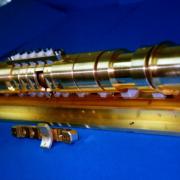Antiproton trap
The preparation of large samples of antiprotons at extremely low energy is an important step on the road to synthesizing antihydrogen (pe+) and antiprotonic atoms (pA+).
The CERN Antiproton Decelerator (AD, http://home.web.cern.ch/about/accelerators/antiproton-decelerator )decelerates antiprotons with GeV-scale kinetic energy to 5.3 MeV, and re-ejects them every 90-120 sec in 100 ns long pulses, containing some 3 x 10^7 particles. This beam energy is, however, still far above the 10 keV range at which antiprotons can readily be captured and cooled in electromagnetic traps.
We replaced ordinary simple degrader foils to reduce antiproton energy by a Radio Frequency Quadrupole Decelerator (RFQD). This substantial decelerator, 4 meters in length, reduced the 5.3 MeV AD beam energy between 10 and 120 keV. Some (5--9) x 10^6 antiprotons within a single shot fulfilled the phase condition necessary for acceptance and deceleration by the RFQD, the remainder being transmitted without deceleration. We expected that the reduced antiproton energy would allow a much larger number of the emerging antiprotons to be captured in a trap placed after the RFQD than is normally the case for simple degrader foils. For these experiments we used a multiring trap (MRT) comprised of several ring electrodes lying perpendicular to the beam and on the axis of a superconducting solenoid at 10 K.
Antiprotons from the RFQD were trapped and cooled in this electro-magnetic trap.

- liquid helium free Superconducting solenoid
- Multi-Ring electrode Trap (MRT)
